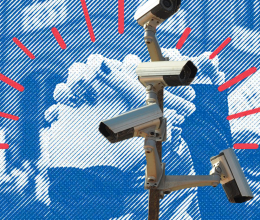
The Milwaukee Police Department uses surveillance technology in schools.
Over the last two decades, a segment of the educational technology (EdTech) sector that markets student surveillance products to schools — the EdTech Surveillance industry — has grown into a $3.1 billion a year economic juggernaut with a projected 8% annual growth rate. The EdTech Surveillance industry accomplished that feat by playing on school districts’ fears of school shootings, student self-harm and suicides, and bullying —marketing them as common, ever-present threats.
Capitalizing on its significant financial resources and political influence, the EdTech Surveillance industry has succeeded in shaping and controlling the narrative around its products. These companies flooded school officials with their own biased marketing materials, promoting their surveillance products as highly effective safety interventions that keep students safe, even though such claims lack independent, unbiased, substantiating evidence. The well-funded EdTech Surveillance industry has likewise benefited from its ability to drown out any discussion of the widespread harms their products cause students.
The ACLU recently released a report, Digital Dystopia: The Danger in Buying What the EdTech Surveillance Industry is Selling, that dives into the booming multi-billion-dollar education technology (EdTech) surveillance industry and the harmful impacts these invasive, and largely ineffective, products have on students. The report looks at the deceptive marketing claims made by popular EdTech surveillance companies and breaks down how they use educators’ fears and unsubstantiated efficacy claims to falsely convince schools that their products are needed to keep students safe. The report also seeks to highlight the substantial harm surveillance causes to students and gives recommendations for school districts to make better informed decisions about using surveillance technologies.
The Milwaukee Police Department and Milwaukee Public Schools launched an app that “allows users to submit real-time tips about suspicious activity and start an anonymous conversation with an MPD officer.” It is unknown what user data is stored by the application and available to police.
Read more:
- Milwaukee police, MPS partner with app to share school safety information
- Wisconsin bill would give schools grants for gun detection software, critics raise privacy concerns
This technology is only one reason why we need a Community Control Over Police Surveillance (CCOPS) ordinance. CCOPS would require oversight and community input in invasive surveillance technologies, allowing the Wisconsinites being surveilled to make informed decisions about their privacy.
Milwaukee deserves to know how the police are surveilling us. Milwaukee needs CCOPS.
